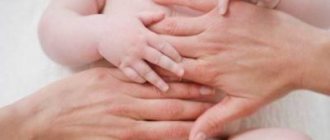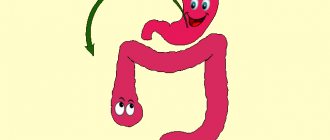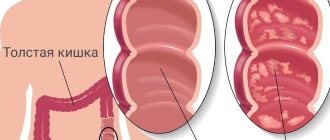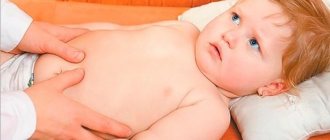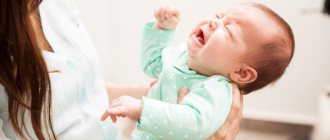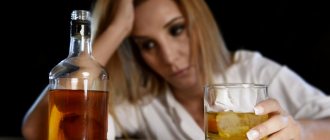Diarrhea in infants: causes and treatment methods
Diarrhea (diarrhea)
- This is an increase in stool frequency and a change in its consistency.
The frequency and nature of stool depends on the age of the child, the type of feeding (breastfeeding, mixed, artificial) and its individual characteristics (Table 1).
So, in breastfed children, the stool in the first six months (before the introduction of complementary foods) is usually homogeneous, mushy, yellowish in color, up to 5-7 times a day. This is the norm. An increase in frequency up to 10 times or more, complete absorption of stool into the diaper - manifestations of diarrhea.
With the introduction of formula and complementary feeding products, stools become less frequent and thicker, and change in color and smell. Bowel movements more than three times a day and a change in consistency to liquid or watery are signs of diarrhea.
Table 1. Stool frequency in young children
| Age | Number of bowel movements per week | Number of bowel movements per day (average) |
| 0-3 months breast-feeding artificial feeding | 5 – 40 5 – 20 | 2,9 2,0 |
| 6 – 12 months | 5 – 28 | 1,8 |
| 1 – 3 years | 4 – 21 | 1,4 |
| 4 years and older | 3 – 14 | 1,0 |
According to the Bristol Stool Form Scale, stool types 5-7 are manifestations of diarrhea and indicate an increase in the speed of passage of the bolus of food through the gastrointestinal tract.
Diet and diet
It is necessary to introduce rice water into the diet.
If a child refuses to eat, there is no need to insist; several hours without food will benefit the body. This reaction protects the digestive organs from excessive strain. With the appearance of appetite, careful introduction of light foods into the diet begins:
- rice water or rice porridge without milk, salt and butter,
- white bread croutons with lean broth from rabbit, chicken, turkey,
- banana or puree from this fruit,
- jelly,
- boiled potatoes without butter and adding milk;
- apple without peel.
If breastfeeding is not yet maintained at this age, then you can put the baby to the breast without restrictions. Food is offered frequently, but in limited portions. Drinking plenty of fluids is a necessity for diarrhea. In case of frequent diarrhea, a child should drink at least 100–150 ml of liquid per hour. It is better if it is ordinary boiled water.
What can cause diarrhea in a baby?
The main causes can be divided into two large groups: infectious and non-infectious.
Viruses, bacteria, fungi and protozoa can cause infectious diarrhea.
Food allergies (FAM), intolerance to food components (lactose), taking antibiotics, pancreatic diseases, as well as congenital diseases can cause non-infectious diarrhea.
When is emergency medical consultation necessary?
In some cases, diarrhea in a child requires immediate medical attention. This is associated with the development of severe complications:
- Diarrhea in a child during the first 3 months of life, especially accompanied by his refusal to breastfeed and/or bottle, which can cause critical dehydration of the child’s body and severe intoxication, with damage to internal organs and the brain.
- Diarrhea with blood in a child of any age.
- Diarrhea accompanied by cramps.
- The development of excessive drowsiness, lethargy and even unconsciousness in a child due to diarrhea.
- Copious repeated watery diarrhea like rice water, which is suspicious for cholera infection.
- The rapid appearance and steady increase of signs of dehydration: lethargy, objectively determined muscle weakness, dry and sagging skin, retraction of the fontanelles and eyeballs. In case of acute diarrhea in a 1-year-old child, dehydration develops within 1 day and it is not always possible to correct it with plenty of fluids.
- A combination of high and unreduced temperature and diarrhea in a child, which indicates severe intoxication, usually of infectious origin.
Diarrhea in a child is a common and not always harmless pathology. But timely and well-chosen treatment allows you to quickly and completely eliminate all symptoms, prevent the development of severe complications, and restore the normal functioning of the digestive tract.
Why is diarrhea dangerous?
Acute watery diarrhea is accompanied by a large loss of fluid and electrolytes. This leads to the development of dehydration (dehydration). Symptoms are shown in Table 2.
Table 2. Dehydration scale
| Sign | Points | ||
| 0 | 1 | 2 | |
| General state | normal | thirst anxiety irritability | sluggish drowsy |
| Eyeballs | without features | slightly sunken | sunken |
| Mucous membranes | wet | somewhat dry sticky | dry |
| Tearing | fine | reduced | absent |
The degree of dehydration is assessed by the sum of points:
| 0 points | no dehydration |
| 1-4 points | mild dehydration |
| 5-8 points | moderate/severe dehydration |
How does it manifest itself?
Stool with diarrhea can have varying degrees of liquefaction: from mushy to watery. Moreover, usually the thinner the discharge, the more abundant it is. In general, the nature of the discharge depends on the predominant mechanism of development of diarrhea.
With diarrhea, increased fluid loss always occurs, which can lead to varying degrees of dehydration.
This is the most potentially dangerous manifestation of the disease for a child, which can cause severe, life-threatening disorders of the brain and other vital organs.
Moreover, the younger the child, the faster signs of dehydration are detected and increase. Therefore, if the child is one month old, then the development of diarrhea is a reason to consult a doctor as soon as possible.
With diarrhea, accompanying signs usually appear, which often help the doctor, even before tests, to preliminarily determine the level of damage and the possible cause of the intestinal disorder:
- Stomach ache. They can be intense cramping, similar to intestinal colic, pulling, aching, bursting. In most cases, they intensify before the next bowel movement. In young children, pain syndrome is detected by indirect signs: increased motor restlessness and tearfulness of the child, pressing his legs to his stomach, crying when applied to the breast (which is explained by increased intestinal activity in response to food intake). But diarrhea in a child without pain can also occur - for example, this is possible with irritable bowel syndrome or functional childhood diarrhea.
- Increased intestinal peristalsis (contractions of the intestinal wall), which can often be heard at a distance and even visible through the anterior abdominal wall.
- The appearance of pathological impurities in the stool. Most often, the child has diarrhea with mucus, but it is possible to detect blood (fresh or already partially changed under the influence of digestive enzymes), and undigested food residues.
- Increased gas formation (flatulence), which makes liquid stool foamy, increases the pressure of discharge, leads to bloating and frequent release of gases with leakage of fluid from the anus.
- Vomit. May appear simultaneously with intestinal disorders or precede them. The combination of vomiting and diarrhea in a child significantly increases dehydration and aggravates the condition.
- Changes in stool color, most often yellow shades characteristic of small intestinal contents. Green diarrhea in a child may indicate a bacterial infection, but this symptom still cannot be classified as a key and unambiguous diagnostic sign.
- An increase in temperature, which may be a manifestation of intoxication and inflammation. But diarrhea without fever in a child is quite common, even if the intestinal disorder is infectious in nature.
What should you do if your baby has diarrhea?
Non-drug therapy
consists of three points.
- Restoring water and electrolyte losses
- Diet therapy
- Probiotics with proven effectiveness
Rehydration therapy
is the use of specialized solutions. It is not just the liquid (water) that is important, but its combination with important components, as in blood plasma.
Usually these are dry powders for preparing solutions.
Diet therapy
consists of reducing the load on the digestive system. This is especially true for milk sugar (lactose) and cow's milk protein. Therefore, it is necessary (temporarily) to exclude any products containing animal milk (cows, goats, mares, etc.).
Breastfeeding must be continued! To reduce the risk of developing lactase deficiency, it is possible to use lactase enzyme preparations in consultation with the treating pediatrician.
It is preferable to replace the regular mixture with a lactose-free one, for example, Nutrilak Premium Lactose-Free, but not completely, but partially (1/3 - 1/2 of the main volume). It is possible to completely switch to a medicinal mixture for the acute period, as prescribed by a doctor.
If there are manifestations of allergy to cow's milk proteins, then the prescription of deeply hydrolyzed Nutrilak Peptide MCT or Nutrilak Premium Soya mixture, which does not contain lactose and BCM, is justified.
Probiotic Lactobacillus rhamnosus (LGG)® and Saccharomyces boulardii.
Only these two types of microorganisms are highly effective in the treatment of infectious and antibiotic-associated diarrhea. At an early age, only the first one can be used. It is especially convenient when baby food is enriched with probiotics. This saves time and does not require a separate dose of the drug with calculation of time, frequency and effort.
What to pay attention to
If diarrhea lasts (more than two weeks) and repeated episodes occur, you should consult a specialist to rule out hereditary diseases and chronic pathology of the gastrointestinal tract.
Recovery period
Intestinal infections deal a big blow to a child’s gastrointestinal tract, so normalizing stool is not a reason to relax and abruptly return to a normal diet or stop taking lactase without the doctor’s permission.
In dishes, preference should be given to cereal products (porridge, pasta) and meat. It is advisable to heat-process vegetables and fruits. It is better to exclude dairy products or replace them with fermented milk. They contain probiotics and their metabolites, which have a beneficial effect on the gastrointestinal tract. In children under one year old, the usual formula can be partially or even completely replaced with a specialized one, for example, Nutrilak Premium Fermented Milk. It helps facilitate digestion, regular bowel movements and maintain microbiota balance.
Diagnostics
During the examination, the pediatrician carefully collects anamnesis and asks whether there were any patients with similar symptoms in the family or in an organized children's group. To exclude acute surgical pathology, assess nutritional status, degree of dehydration, and perform a physical examination. A number of diagnostic methods are used to determine the cause of diarrhea:
- Ultrasound of the abdominal cavity.
Sonography is a fast and non-invasive method that allows you to exclude urgent surgical conditions and study the structural features of the gastrointestinal tract. During the examination, the doctor can detect chronic inflammatory processes, congenital developmental anomalies, signs of damage to the liver, pancreas and other organs. - X-ray of the gastrointestinal tract.
In case of chronic diarrhea, the gastroenterologist is interested in the condition of the walls of the stomach and intestines, so he prescribes X-rays with barium contrast. Irrigography helps to exclude damage to the colon. - Stool tests.
Typical deviations in the coprogram: the presence of undigested food particles, striated muscle fibers, increased levels of mucus and leukocytes. Stool culture is performed to exclude bacterial intestinal infections. Viral pathogens are identified using stool PCR. - Blood tests.
Clinical and biochemical tests are needed to assess the general condition of the child and diagnose the presence and degree of dehydration. Serological reactions are used to identify infectious pathogens in severe cases and generalization of the disease.
Stool culture
Surgical pathologies
Inflammation of the appendix is difficult to diagnose in a baby in the first year of life, since the baby cannot show where it hurts. The disease is dangerous because it develops at a hurricane pace. And from the onset of the inflammatory process to the rupture of the organ, only a few hours can pass.
Symptoms of the pathological process:
- anxiety;
- weakness and apathy - the baby lies and does not want to play or move;
- forced pose - the toddler turns over on his right side and assumes a fetal position;
- fever, chills, fever;
- lack of appetite with increased thirst;
- vomit;
- diarrhea is profuse and repeated.
Such symptoms require immediate hospitalization of the child in the surgical department. If diagnosis is difficult, diagnostic laparoscopy is indicated.
Intestinal abnormalities
Lactobacilli - to normalize intestinal microflora
Malformations of the gastrointestinal tract system develop in the prenatal period, but appear after the birth of the baby.
Most often diagnosed:
- pathologies associated with intestinal rotation;
- narrowing of the intestinal lumen or its complete closure;
- fusion of the rectum, anus;
- disruption of the conductivity of the peripheral nervous system, which oversees the functioning of the intestines;
- organ doubling;
- diverticulitis.
These processes are rarely accompanied by diarrhea; intestinal obstruction often develops. The diseases are accompanied by pain, and bleeding from the anus is possible. The treatment of all these conditions is exclusively surgical.
With prolonged diarrhea, intestinal abnormalities should be excluded when making a diagnosis.
What is the type of stool in formula-fed children?
In bottle-fed babies, the feces are the same yellow and mushy-like as in babies raised on breast milk. But feeding with mixtures can provoke the appearance of darker and thicker stools. This is considered the norm. The color of the stool may vary, depending on the composition of the mixture, from pale yellow to brown.
Since more time is spent on digesting the artificial mixture, the number of bowel movements is reduced by approximately half. The volume of stool is larger. It is quite acceptable for artificial patients to retain stool for up to 2 days. If the baby is calm and has no gas, then the parents have no particular reason to worry.
